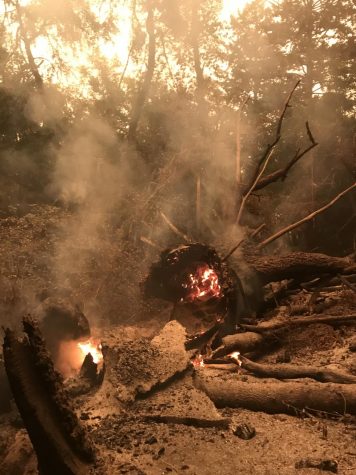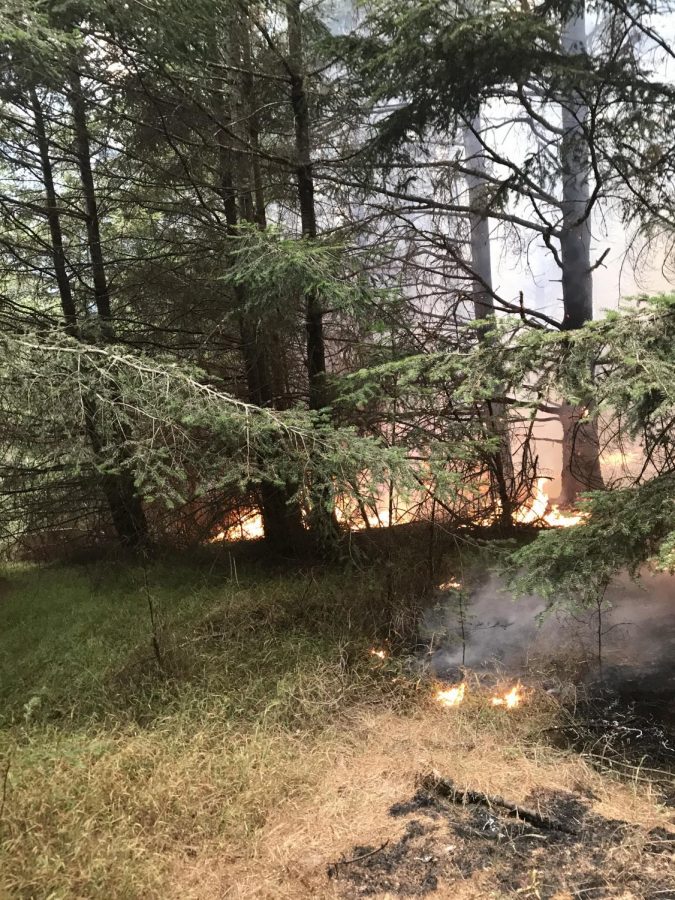Point Reyes’ Woodward Fire Leaves the Habitats of Threatened Species In Question
September 26, 2020
On Monday, August 17, 2020, lightning strikes sparked wildfires in Point Reyes National Seashore. Animals that could escape fled from the blaze, abandoning their homes and irreplaceable habitats. Just a day later, a second fire, the now named Woodward Fire, began and quickly grew in size with the aid of large winds. As the two fires merged, they began to consume the habitats of more than 50 threatened and endangered species.
The Woodward Fire is burning in heavy coastal shrub, as well as an older growth of mixed conifer, coastal forest. The low fuel moisture values and historic maximum ERC have contributed to the active fire’s aggression. Additionally, the fire is burning in an area lacking recent fire history, meaning there is an abundance of dead foliage fueling the blaze.
By the evening of Monday, September 21, the Woodward Fire had grown to 4,929 acres in size and was 97% contained.
While the firefighters and members of the National Park Service are beginning to get the fire under control, ecologists and wildlife activists are attempting to predict the extent of the damage. Since the Point Reyes National Seashore is home to so many endangered and threatened species, there is well-founded concern that the Woodward Fire, as well as the ever-increasing amount of wildfires across the state, might leave various lasting impacts on the animals and their habitats.
However the only thing known so far is that it’s too early to know anything.
“The effects are really going to depend on how severe the fire burned in different areas,” says Dave Press, a wildlife ecologist with the Point Reyes National Seashore. “There might be some areas where it has burned with low intensity, so we may see recovery within a couple years. Whereas in an area with a really high intensity burn there might be permanent changes.”
These changes could range anywhere from the forest becoming an entirely different vegetative community to the extinction of an entire species. While the lasting effects of the Woodward fire are yet to be seen, there is a pattern to how a wildfire impacts certain types of ecosystems in California.
One thing ecologists are doing is referring to the Mount Vision Fire, which burned parts of Point Reyes in October of 1995. This has given experts a glance into how the Woodward fire might impact the habitat and wilderness in the areas that were burned.
According to Susan Prichard, a forest ecologist with an expertise in wildfire ecology, “If the trees survived the past [Mt. Vision] fire, then it means that the past fire acted like it gave the forest a bath, cleaned out a lot of the understory and burned through those deeper organic soils.” This means that new fires would be easier to control and not nearly as devastating in areas that have survived previous fires.
Experts talk about the next fires, or re-burn, being less severe because there’s less fuel to burn. “It’s very possible that some of those trees because they had a fire 25 years ago have a better chance of surviving this time,” says Prichard.
However in many areas, the forests have expanded. And it’s in these newer areas that burns occur at a higher intensity during the summer, meaning more trees die.
 Wildfires are a natural part of the environment in California. However, since there has been a lot of fire exclusion in Point Reyes, there have been very few controlled fires set to clear out old brush. As a result, these areas have a build up of coarse wood and organic soil, which can fuel a burn for quite a long time after the main fires.
Wildfires are a natural part of the environment in California. However, since there has been a lot of fire exclusion in Point Reyes, there have been very few controlled fires set to clear out old brush. As a result, these areas have a build up of coarse wood and organic soil, which can fuel a burn for quite a long time after the main fires.
“The lightning, summer heat, droughts, and wind can lead to really devastating wildfires,” says Press, “So couple those climate related effects with the history of essentially suppressing fires as a management strategy throughout our California forests…now they’re burning hot and they’re burning fast and in a really dramatic, large fashion.”
The most significant habitat impacted by the Woodward Fire is an extremely tall Douglas Fir Forest, home to the two species at the most risk from the fires: the Northern Spotted Owl and Point Reyes Mountain Beaver.
Since the Northern Spotted Owls are a territorial species, they have their own unique home range. These different territories are closely monitored each year by the National Park Service. According to Press, “The burn passed through at least six known spotted owl territories, and we don’t know yet how hot the fire burned in those areas.”
Similar to the owls, the Point Reyes Mountain Beaver also exists in these Douglas Fir forests, while also out in some of the chaparral habitat. This particular beaver species is almost on the prehistoric level in terms of how old it is evolutionarily. This particular beaver species is endemic to Point Reyes, meaning it exists nowhere else in the world.
“The 1995 fire, the Vision fire, burned really really hot through some of them out in beaver colonies and there was an estimated 95% mortality inside these colonies,” explains Press. “But then again it’s one of those things where we don’t know yet what the impact might be for this Woodward fire. We haven’t been able to get in there and make those on-the-ground assessments yet.”
Until the fire is brought completely under control and it is safe to make inspections, the fate of these animals and their habitats remain in speculation. For the endemic species, these fires may even lead to extinction.
Despite these grim facts, there is actually hope that much of the wilderness and habitat will prevail. There has been a long history of fires in Point Reyes, and of the fifty threatened species that call that home, many of them are fire adapted.
While the majority of the Woodward fire is burning in the forests, the fire has also burned part of the coastal chaparral habitat. These coastal shrub ecosystems contain coastal sage and coyote brush, which are types of shrubs that are very flammable and burn hot, so it doesn’t take much to start them in summer wildfires. “But the nice thing about chaparral is even in a really hot summer with drought they tend to come back. They tend to reseed or sprout, so that’s the good news with these areas of habitat after a wildfire,” explains Prichard.
According to Ms. Pikk, the AP Environmental Sciences (APES) teacher at SRHS, “Coastal shrubbery or chaparral is one of the biomes or habitats that has evolved with fire, and will be able to rebound through secondary succession after a fire to something that was similar to what was there before.”
Since the coastal shrubbery had no problem growing back after the Vision Fire, the only concern about the Woodward burning in the chaparral shrubbery is that non-native grass will compete with the shrubs in certain areas as they try to come back.
As the uptick in fires has become increasingly severe, there has been an increase in activism surrounding the issues of both climate change and the protection of the wilderness. Dianna Oppenheim, founder of the public awareness campaign called “Save the Tule Elk,” is well known for her passion for the wildlife of Point Reyes. When asked about her concern for the wildlife and habitat impacted by the Woodward fire, she said “I think one of the worst things people can go through is having to lose your home. Every animal who lives in the wilderness is also losing their home, and humans don’t always think about that.”
The rising concerns about climate change and its ability to influence the amount of wildfires has led to some debate about how to prevent the continued devastation of ecosystems in the future, and it’s not something that is simply discussed among environmentalists.
Bella Genolio, a senior at SRHS, says “the sporadic climate changes, with the lightning and the extreme heat, and the dry beginning of the year, is a perfect environment to have fires. And because of this not normal climate that we’re in, it’s just gonna keep happening if we don’t do anything about it.”
However, according to Prichard, “Fires become self limiting. It’s actually not always the case to just say it’s climate change, we’re just going to get larger and more severe fires in perpetuity, that’s not a case. As soon as we get fires bumping into old fire scars, then they’re going to be a little more and more self-limiting.”
For now there is a huge build up of fuels from lack of fire, resulting in more significant damage than in previous years. As a result, in this current age of massive and rampant wildfires, environmentalists and activists alike are paying extra care to endangered or threatened species in order to ensure that they prevail.
“There’s a ton of endangered species in Point Reyes, it’s a biological hotspot,” explains Oppenheim, “There’re plants in Point Reyes that can’t be found anywhere else in the world. To lose these could be a pretty significant loss to wilderness.”
“There’s always winners and losers after a fire,” explains Prichard, “some of the big time winners are woodpeckers. They come in and really do well with all the forest insects that come in on the dead and dying trees. It’s actually interesting when considering the fact that we’re getting fires that it might not be so good for them now, but in the past many of these same species, kind of ironically, benefited from wildfires.”
Over time, as more and more wildfires burn, the stockpile of organic fuels will be regularly cleared and the fires won’t necessarily be as big as they currently are. This may eventually return California to its original state before the fire suppression began, providing the benefits of periodic fires back to the forests and chaparral habitats across the state.
A potential break in severe fires will likely give the wildlife and habitat of Point Reyes the time it needs to recover from the Woodward Fire, and will ensure that any future fires will be far weaker due to a lack of organic fuel.
Perhaps the solution to the ever increasing wildfires, is simply the wildfires themselves. And maybe in this case, fighting fire with fire might not be such a bad idea.







































Julia • Oct 5, 2020 at 12:10 pm
I really liked this article. It was very easy to understand and very informative about the wildfire.